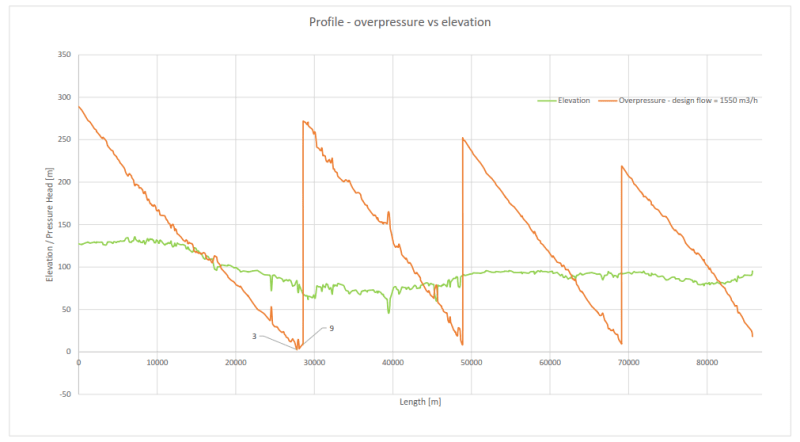TomaszKruk
Civil/Environmental

Hello,
I'm at an conceptual stage of a long water line problem and hope the forums can help me. I don't have to design anything specific just yet. I'm hoping someone could give me some general guidelines.
I am to design a water pipeline and assumed high pressure losses due to contaminants settling on pipe's walls. I've done the darcy-weisbach calculation and decided the Customer would need to build intermediate pumping stations. After some work I've selected what I think are the best locations given circumsatnces (away from houses, near roads, etc), but it turns out I might have a problem with the first location - it's in a depression in terrain, which means overpressure might go near 0 just before it, and with some bad luck (with decreased flow or during transients) the pressure might go into the negative.
Air realease - vacuum valves will be installed on the line, but I've been thinking if I shouldn't rise the pressure at the "0" pumping station anyway. The deal is - what is the maximum safe pressure I can assume at pumping station "1" (the one near 30 000 m mark)? I don't want to assume anything unreal or non-standard. The values given on the graph already includes 5 m of overpressure at the pumping station "1" tank. I would say this scenario would be solved if I assume pressure head of 20 m at tank's inlet. I am, however, worried about the mass of water eroding the tank (it's around 1500 m3/h).
Just to complicate things - if I assume lower flow, and operation with intermediate pumping stations not bypassed, the local pressure minimums become even worse, and I'd need to increase pressure at the starting pumping station even further. What maximum could you say is still considered standard?
Having done some research previously I would prefer to avoid any slack line. I'm also afraid that throttling the flow at the tanks inlet might cause problems with transients and the design of control equipment.
My company will not design pumping station "0" (the one at 0 meters). We might, hopefuly, be the ones to design the intermediate pumping stations together with the tanks themselves (underground concrete slabs).
I would also be really grateful for anyone pointing me to books, documents, or manufacturers that might provide guidelines to design either means of reducing pressure at the inlet or diffusing it.
Regards,
Thomas
